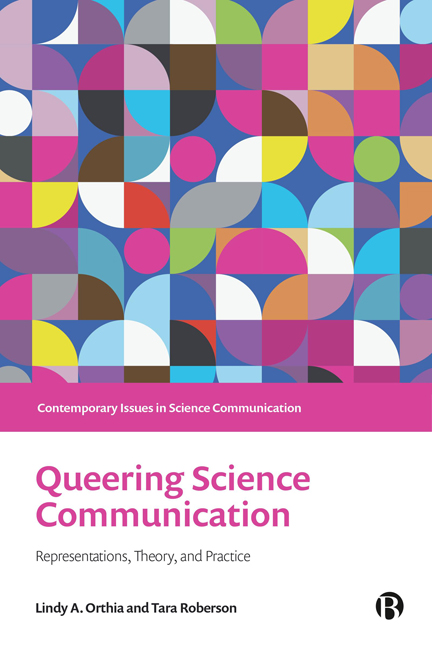Book contents
- Frontmatter
- Contents
- Series Editor Preface
- Notes on Contributors
- Acknowledgements
- Terminology and Sensitive Content in This Book
- Introduction
- PART I Negotiating Queer Identities with Science, Technology, and Medicine
- PART II Representations of Queerness in Public Science Communication
- PART III Queer People in Science Communication Communities
- PART IV Queering Institutional Science Communication Agendas
- Conclusions
- Index
5 - Queer Characters in Science-themed Fiction
Published online by Cambridge University Press: 18 January 2024
- Frontmatter
- Contents
- Series Editor Preface
- Notes on Contributors
- Acknowledgements
- Terminology and Sensitive Content in This Book
- Introduction
- PART I Negotiating Queer Identities with Science, Technology, and Medicine
- PART II Representations of Queerness in Public Science Communication
- PART III Queer People in Science Communication Communities
- PART IV Queering Institutional Science Communication Agendas
- Conclusions
- Index
Summary
Media representations of scientists have been a mainstay topic of science communication research for decades.
In addition to examining representations of scientists and other STEM professionals such as engineers and mathematicians in news media, science communicators have examined their representation in fiction texts such as films, television, theatre, novels, and comics. They have conducted this research for a range of reasons including to evaluate equality of representation among scientist characters by genders, ethnicities, and disciplines (for example, Long et al, 2010), and to investigate how characters in sciencethemed fiction promote particular ideologies such as scientism (for example, Orthia, 2011).
The ultimate rationale is often to understand what impact fictional representations of STEM professionals have on public discourse, for example on people's concepts of what scientists are like or who can be an engineer. Sometimes this is framed as investigations of fiction's role-modelling capacity for STEM careers (for example, Steinke et al, 2012). In other cases, the rationale is to sample fiction as a manifestation of existing public discourse, to find out what a particular society already thinks about science, its personnel, and the ‘others’ it contrasts itself to (for example, Haynes, 1994).
However, almost none of this work has attended to fictional representations of queerness. That is the case whether it refers to diversity in scientific characters’ sexual orientation, gender, and sex characteristics, or fiction's depictions of queer issues in science.
Indeed, diversity in gender and sex characteristics has been rendered still more invisible than usual by the field's analytical conventions. Most studies examining the gender or sex of scientist characters look only at differences between ‘women’ and ‘men’, implicitly assuming a cis-binary model of gender and sex that is not questioned or even mentioned. Such assumptions patently exclude gender diverse people and people with diverse sex characteristics who don't identify as female or male. Non-heterosexuals are also often overlooked by analysts who presume characters are heterosexual unless canonically proven otherwise. As well as perpetuating harm to queer people specifically, such analytical decisions do the field a general disservice by keeping discourse about inclusion at a superficial level.
- Type
- Chapter
- Information
- Queering Science CommunicationRepresentations, Theory, and Practice, pp. 89 - 108Publisher: Bristol University PressPrint publication year: 2023

